105 14.3 Groundwater Extraction — Physical Geology – 2nd Edition
14.3 Groundwater Extraction
Except in areas where groundwater comes naturally to the surface at a (a place where the water table intersects the ground surface), we have to construct wells in order to extract it. If the water table is relatively close to the surface, a well can be dug by hand or with an excavator, but in most cases we need to use a drill to go down deep enough. There are many types of drills that can be used; an example is shown in Figure 14.3.1. A well has to be drilled at least as deep as the water table, but in fact must go much deeper; first, because the water table may change from season to season and from year to year, and second, because when water is being pumped, the water level will drop, at least temporarily.

Where a well is drilled in unconsolidated sediments or relatively weak rock, it has to be lined with casing (steel pipe in most cases) in order to ensure that it doesn’t cave in. A specially designed well screen is installed at the bottom of the casing. The size of the holes in the screen is carefully chosen to make sure that it allows the water to move into the well freely, but prevents aquifer particles from entering the well. A submersible pump is typically used to lift water from within the well up to the surface where it is needed. The well shown in Figure 14.3.1 has casing that is about 40 centimeters in diameter, which might be typical for a municipal water supply well, or a very large well for irrigation. Most domestic wells have 15 centimeter casing.
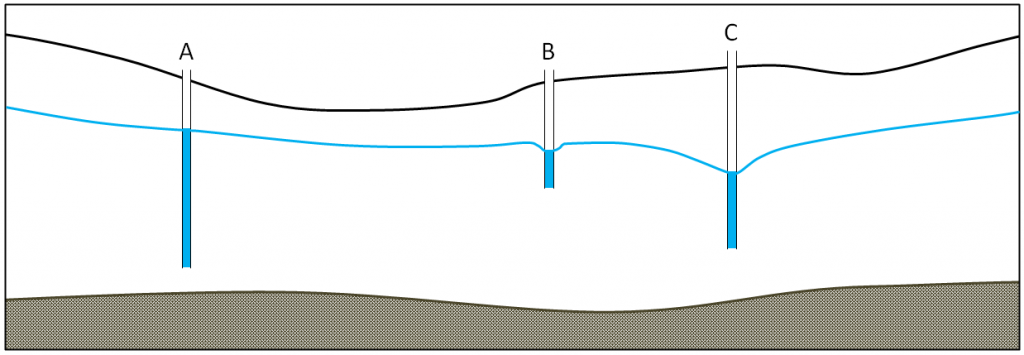
Pumping water from the well removes water from inside the well at first. That lowers the water level inside the well. This means that water will flow from the surrounding aquifer toward the pumping well where the water level is now lower.
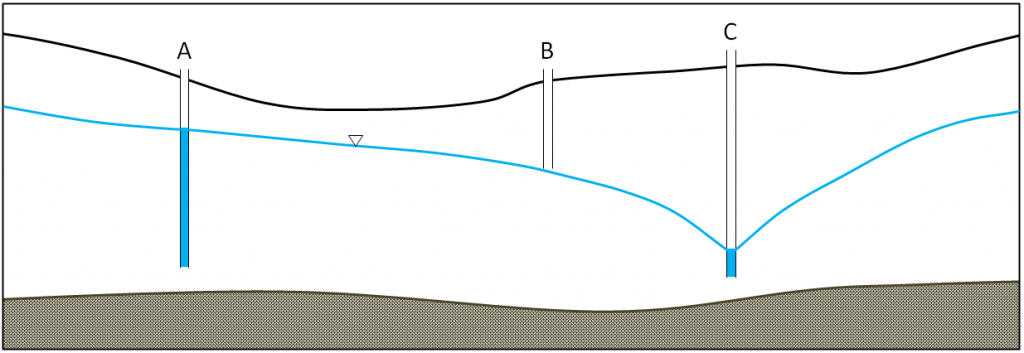
That is how a well gets water from the ground. The water table, or potentiometric surface, will slope in toward the well where the water is being withdrawn. That indicates the energy gradient that is allowing water to flow toward the well. This creates a shape known as a cone of depression surrounding the well, as illustrated in Figure 14.3.2. If pumping from a well continues for hours to days, the cone of depression may result in a loss of water in nearby wells. As shown in Figure 14.3.3, pumping of well C has contributed to well B going dry because the water level is now below the bottom of well B. If pumping continues in well C, it too may go dry.
The two diagrams here show the same well before (left) and after (right) long-term pumping. A cone of depression has developed. This provides the energy gradient for water to flow toward the well so that it can be pumped out.
How will this likely affect the rate of flow into the well?
See Appendix 3 for Exercise 14.2 answers.
Like other states, Colorado has a network of observation wells. These are wells that are installed to measure water levels; they are not pumped. There are over 2,000 active observation wells in Colorado (as of 2017), most equipped with automatic recorders that monitor water levels continuously. The main purpose of the observation wells is to monitor water table levels so that we can see if there are long-term natural fluctuations in groundwater quantity, and shorter-term fluctuations related to overuse of the resource. Most are also sampled regularly to monitor groundwater chemistry and quality. Wells are typically visited once per year to collect this data, and are maintained by the Colorado Division of Water Resources. An example of an observation well is illustrated in Figure 14.3.4, with an in-depth schematic provided in Figure 14.3.5.

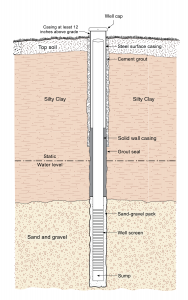
Water-level data from Colorado’s observation wells, like most other states, are available to the public, and an example data set is illustrated in Figure 14.3.6 (taken from the Colorado Division of Water Resources). The water level in Castle Oaks (TDW 9) – situated in Castle Rock, CO – dropped significantly from 1986 (average depth around 500 ft), to 2009 (average depth around 750 ft), but has recovered a little since then.
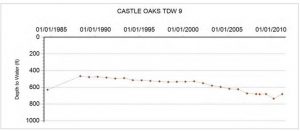
In most of Colorado most wells drop to their lowest levels in September or October after the relatively dry summer period. Levels increase rapidly from October through March as high winter precipitation adds recharge to the aquifer, and water is stored. The water table typically reaches a peak in April or May. Most wells then drop over the summer as groundwater continues to flow, but no new recharge is added. The water is drained from storage into streams or lakes and eventually into the ocean, and as a result, the water table decreases, reaching its lowest level again in September or October. Similar fluctuations are observed at most observation wells around the province, although the timing is slightly different from region to region.
The long-term fluctuations in levels in observation wells in different places are also quite variable. Long-term changes in climate can lead to gradual natural changes in water levels. These long-term cycles lasting years or decades are mixed with the effects of well pumping. Some observation wells show consistent decreases in water level that may indicate long-term over-extraction. Many others show generally consistent levels over several decades, and some show increases in water level. One of the important jobs performed by hydrogeologists working for government agencies is to examine these long-term records of water levels for indications of how sustainable the groundwater use might be.
In 2015 the Colorado Water Plan was passed, which provides a series of programs aimed at meeting ever-growing water demands while preserving pristine lakes and rivers, especially with the challenges that global warming presents. A few examples of the plan’s goals include: obtaining a storage level of 400,000 acre feet (1.3 x 1011 gallons) by 2050, improving public awareness programs that water is not infinite, and water banking programs to support heavily-agricultural communities, to name just a few. Filler details of the state’s water action plan can be accessed at https://cwcb.colorado.gov.
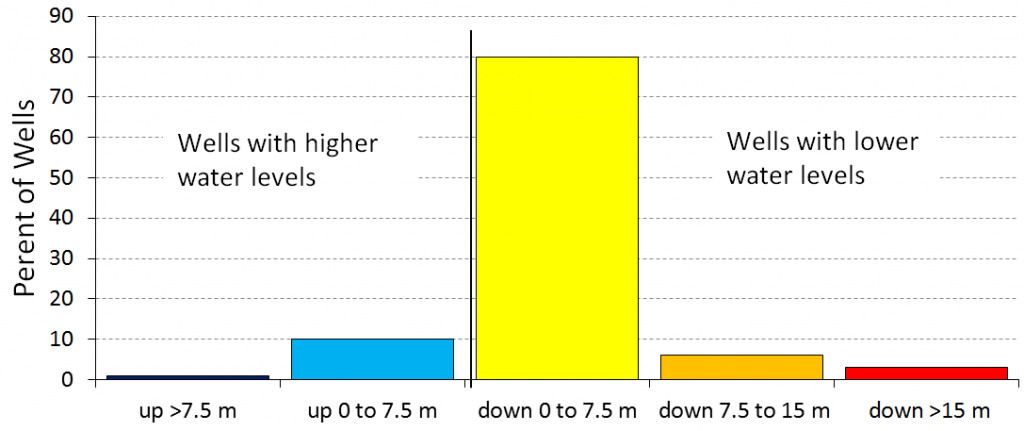
The groundwater situation in California is perhaps one of the most severe of any state. According to the state Department of Water Resources, 80% of groundwater wells showed drops in water level of 0 meters to 7.5 meters between 2011 and 2013, another 6% dropped by 7.5 meters to 15 meters, and 3% dropped by more than 15 meters (Figure 14.3.7). Over the same time period, only 10% of well levels increased by 0 meters to 7.5 meters, and 1% increased by more than 7.5 meters. The drought that gripped California in 2013 had worsened significantly by 2015, and California farmers — and the people across North America that eat the food they produce — continue to have a prodigious appetite for irrigation water.
Impermeable Surfaces
Even if groundwater supplies are not being depleted by overuse, or by a changing climate, we are continuing to put stress on aquifers by covering vast areas with impermeable surfaces that don’t allow rain and snow-melt to infiltrate and become groundwater. Instead, water that falls on these surfaces is channeled into drainage systems, then into storm sewers, and then directly into rivers and the ocean. In cities and their suburbs, the biggest culprits are parking lots, roads, and highways. While it would great if we didn’t dedicate such huge areas to cars, that’s not about to change quickly, so we need to think about ways that we can improve surface water infiltration in cities. One way is to use road and parking surfaces that will allow water to seep through, although this is not practical in many cases. Another way is to ensure that runoff from pavement is channeled into existing or constructed wetlands that serve to decontaminate the water, and then allow it to infiltrate into the ground.
Media Attributions
- Figure 14.3.1, 14.3.4: Wikimedia Commons
- 14.3.2, 14.3.3: © Steven Earle. CC BY.
- Figure 14.3.5: Colorado Geological Survey
- Figure 14.3.6: Colorado Division of Water Resources, Public Domain
- Figure 14.3.7: © Steven Earle. CC BY. Based on data from “Observation Well #232.”

